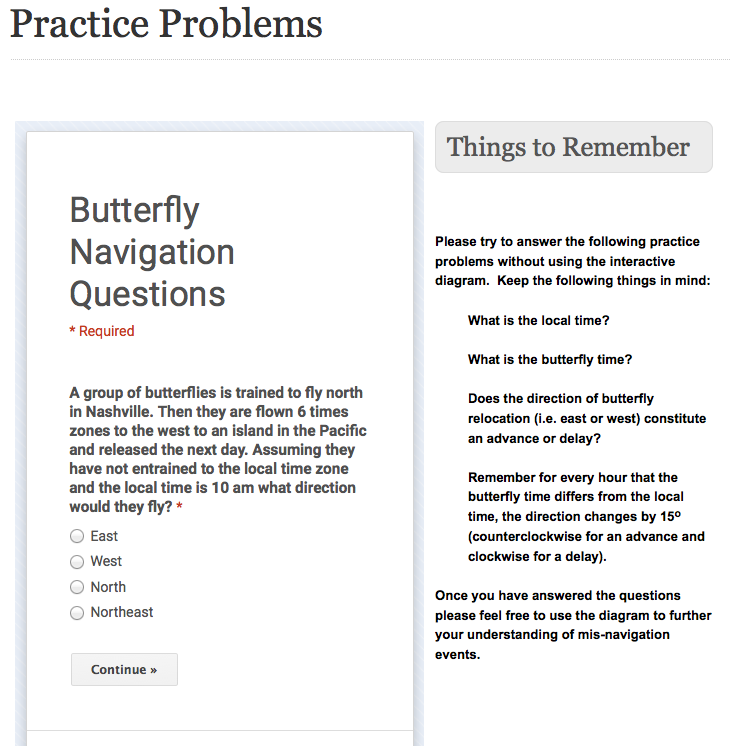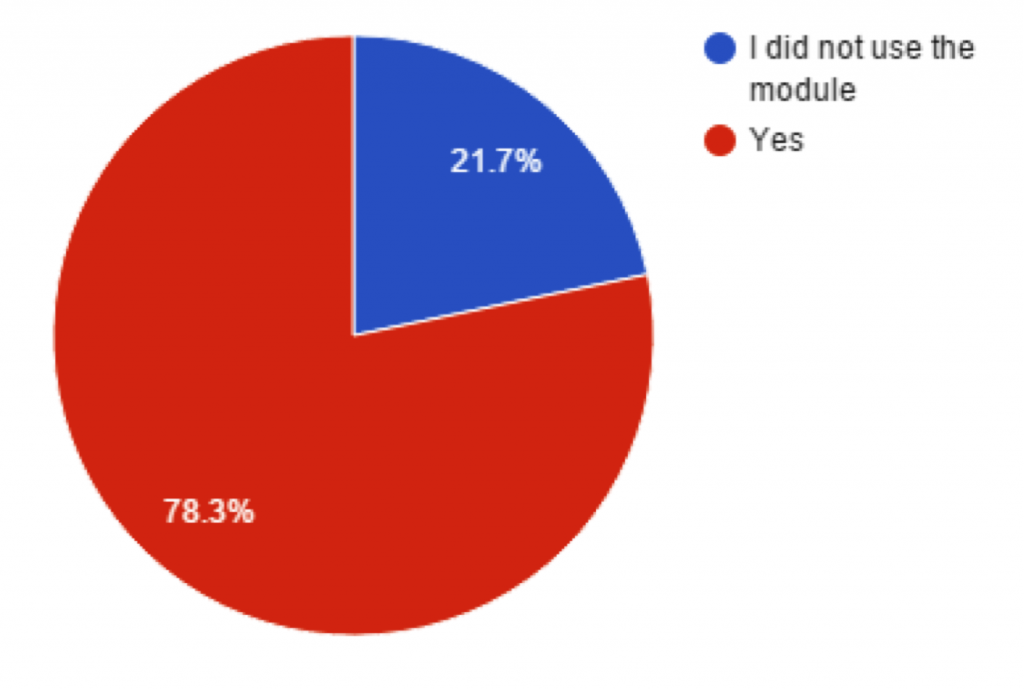BSCI 232: Biological Clocks

Noah Green, Biological Sciences, working with Douglas McMahon, Professor of Biological Sciences
Overview
Dr. Douglas McMahon has been teaching the biological clocks class here at Vanderbilt for the last several years. One of the subjects studied in this class is the concept of “time compensated sun compass navigation”. Put in simpler terms, this is the process of how animals can use the time of day (measured by their internal circadian clocks) and the position of the sun to navigate in a constant direction. One of the best examples of this concept is the incredible migration of the Eastern North American monarch butterfly. These butterflies undergo a migration of almost 2,500 miles from the northern US and southern Canada to central Mexico using this form of navigation.
To illustrate how the internal circadian clock of the butterflies plays a critical role in their navigation Dr. McMahon outlines how changing the butterfly’s internal circadian time vs. the actual local time can cause mis-navigation events. Unfortunately, students consistently have a hard time grasping this concept due to the multivariable nature of the time compensated sun compass navigation. In order to aid in the conveyance of this concept, Dr. McMahon and I have developed an online module providing more in depth information about the migration and navigation of the butterflies as well as several tools to allow students to test their understanding.
The module is hosted on a WordPress-based website. The website includes three separate sections:
The first section is composed of three instructional videos intended to provide a more comprehensive view of monarch butterfly migration and navigation.
The first is an introductory video outlining the project and our reasons for constructing the module. The second video outlines the migration patterns of these butterflies as well as the threats human interference can pose to the butterflies and their migration. The final video describes the biological processes underlying time compensated sun compass navigation and how mis-navigation events may occur.
In creating these videos, we tried to keep in mind key elements of the Richard Mayer’s Cognitive Theory of Multimedia Learning, segmenting the videos such that students can grapple with concepts in small chunks; signaling the important elements with visual cues; weeding out extraneous information, particularly when explaining complex concepts; and using auditory and visual channels for information processing in complementary ways. When describing more complex concepts, we also included in-video questions to provide students a chance to pause, reflect, and assess their understanding.
The second section contains a series of practice problems that allows students to test their understanding of mis-navigation events. This element is key for helping students actively process the complex information. Along with the practice problems, we give students “things to think about,” which signal the key elements that they should consider to solve the problems.
The third section is composed of an interactive diagram that allows the students to change the parameters involved in time compensated sun compass navigation such as initial orientation direction, local time and internal butterfly time. Changing these parameters in the diagram moves an arrow on a compass face indicating which direction the butterflies would travel with any combination of the base parameters. This tool provides an alternate way for students to visualize the problems, and also may serve as a tool to help them generalize the relationships in time compensated sun navigation.
Our goal is that this module will allow students to gain a more complete understanding of the concept of time compensated sun compass navigation through detailed instruction and experiential learning. In addition, we hope this module will increase student’s appreciation for this incredible biological event and the animals that carry it out.
Assessment
We will assess these goals using three distinct methods:
1. We will randomly divide the biological clocks class into two groups, one of which will have access to the module and one will not. The students will be assigned a set of practice problems regarding time compensated sun compass navigation which will result in a completion credit while performance on the practice problems will not affect their grade. Once they have completed the problems we will score them to determine which group performed better on average. Once they have completed this set of questions all students will be given access to the module before the first exam.
2. The first exam in the course contains several questions regarding time compensated sun compass navigation. Therefore we will be able to compare the current student’s scores on these questions (who will have access to the module) to student scores from last year’s class (who did not have access to the module) to determine if there is an overall difference in performance on test questions concerning time compensated sun compass navigation.
3. Finally, after the first exam the students will be given a survey to complete concerning the success of the module. This survey will include questions such as: Did you use the module in preparation for the exam? If so did you find it helpful? Which portion of the module did you find most helpful? And so on. This will give us a qualitative idea of the success of the module.
Visit the Eastern North American Monarch Butterfly Migration and Navigation Website
Results
 We implemented our module in Dr. McMahon’s Biological clocks class during the fall 2015 semester. After Dr. McMahon gave the lecture covering time compensated sun compass navigation covering how butterflies use this phenomenon to navigate, we assigned all 37 students a problem set for homework. These problems asked the students to consider how the misalignment of the butterfly’s internal circadian clock with the external time would cause the butterflies to misnavigate. Nineteen of the students were allowed access to our online module and 18 were not allowed access. Students who were allowed access to the module scored significantly higher on this homework than those who were not allowed access. The graph shows mean scores, with error bars indicating standard error of the mean; a one-way ANOVA with Dunn’s multiple comparison post-hoc test yielded p < 0.005.
We implemented our module in Dr. McMahon’s Biological clocks class during the fall 2015 semester. After Dr. McMahon gave the lecture covering time compensated sun compass navigation covering how butterflies use this phenomenon to navigate, we assigned all 37 students a problem set for homework. These problems asked the students to consider how the misalignment of the butterfly’s internal circadian clock with the external time would cause the butterflies to misnavigate. Nineteen of the students were allowed access to our online module and 18 were not allowed access. Students who were allowed access to the module scored significantly higher on this homework than those who were not allowed access. The graph shows mean scores, with error bars indicating standard error of the mean; a one-way ANOVA with Dunn’s multiple comparison post-hoc test yielded p < 0.005.
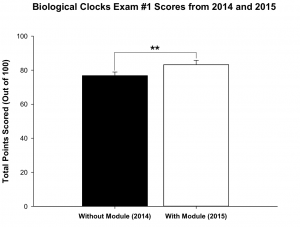
After completion of this homework assignment, all students were allowed access to the module to prepare for the first exam. The exam contained three butterfly navigation questions, worth 4 points each (accounting for 12% of the total exam score). We compared exam scores from 2014 in which students did not have the benefit of the module to exam scores from this year (2015) in which students had access to the module while preparing for the exam. Students who had access to the module (2015) performed significantly better on the exam as a whole than those who did not have access to the module. Again, the graph shows mean scores, with error bars indicating standard error of the mean; a one-way ANOVA with Dunn’s multiple comparison post-hoc test yielded p = 0.005.
We were able to compare scores on the butterfly questions themselves from 13 exams that were not claimed by students in 2010 and 2014 to the scores from the 37 students who took the exam in 2015. Students who had access to the module performed astoundingly better on butterfly navigation questions than those who did not have access to the module in previous years. The graph shows mean scores, with error bars indicating standard error of the mean; a one-way ANOVA with Dunn’s multiple comparison post-hoc test yielded p = 0.001.
 However, since the exams that were analyzed from previous years were from those students that did not claim their exams we worried there may be a sampling bias toward a certain cohort of students. Therefore, we normalized the student’s performance on the butterfly navigation
However, since the exams that were analyzed from previous years were from those students that did not claim their exams we worried there may be a sampling bias toward a certain cohort of students. Therefore, we normalized the student’s performance on the butterfly navigation 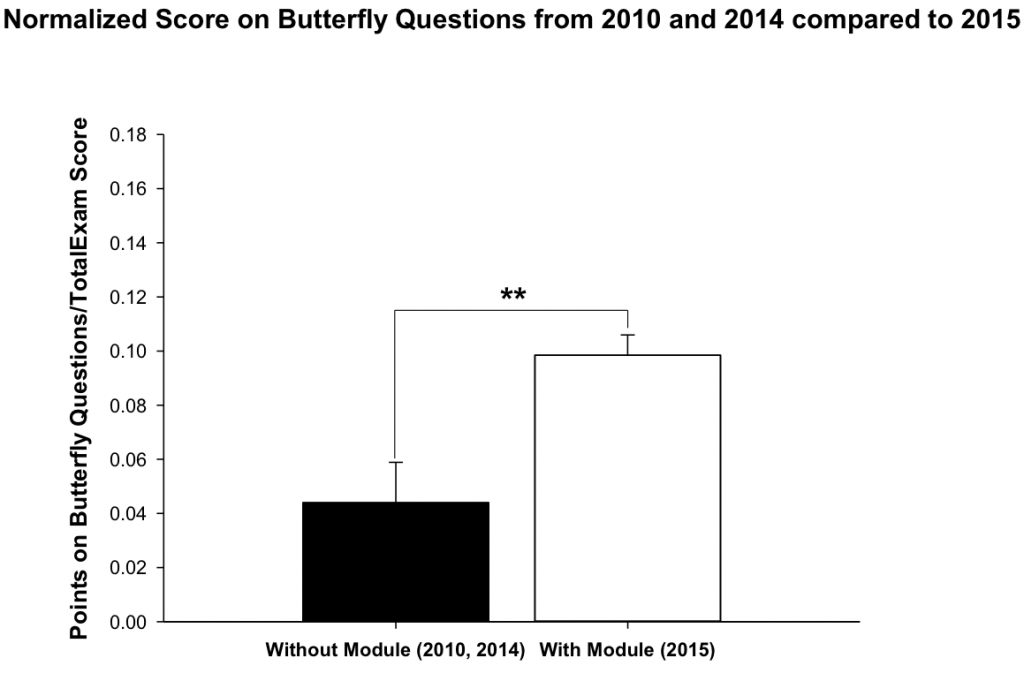 questions to their total score on the exam to make sure we were not sampling from a population of students who did not perform well on the exam as a whole during previous years. We found that the ratio of butterfly navigation question scores to total exam scores was still significantly higher for students who had access to the module than those that did not, suggesting the sampling bias did not influence the results significantly. The graph shows mean scores, with error bars indicating standard error of the mean; a one-way ANOVA with Dunn’s multiple comparison post-hoc test yielded p = 0.003.
questions to their total score on the exam to make sure we were not sampling from a population of students who did not perform well on the exam as a whole during previous years. We found that the ratio of butterfly navigation question scores to total exam scores was still significantly higher for students who had access to the module than those that did not, suggesting the sampling bias did not influence the results significantly. The graph shows mean scores, with error bars indicating standard error of the mean; a one-way ANOVA with Dunn’s multiple comparison post-hoc test yielded p = 0.003.
Finally, students were given a survey to assess how valuable they thought each portion of the module was to their understanding of the concept of time compensated sun compass navigation. Out of 27 responses, 78.3% of students stated that they had used the module to prepare for the exam.
.
They were then asked to rate the value of each section of the module on a scale from 1 to 5 (1 being of no value and 5 being very valuable). Overall students stated that the practice problems were the most valuable, with all students rating the value of the practice problems with a 3 or above.
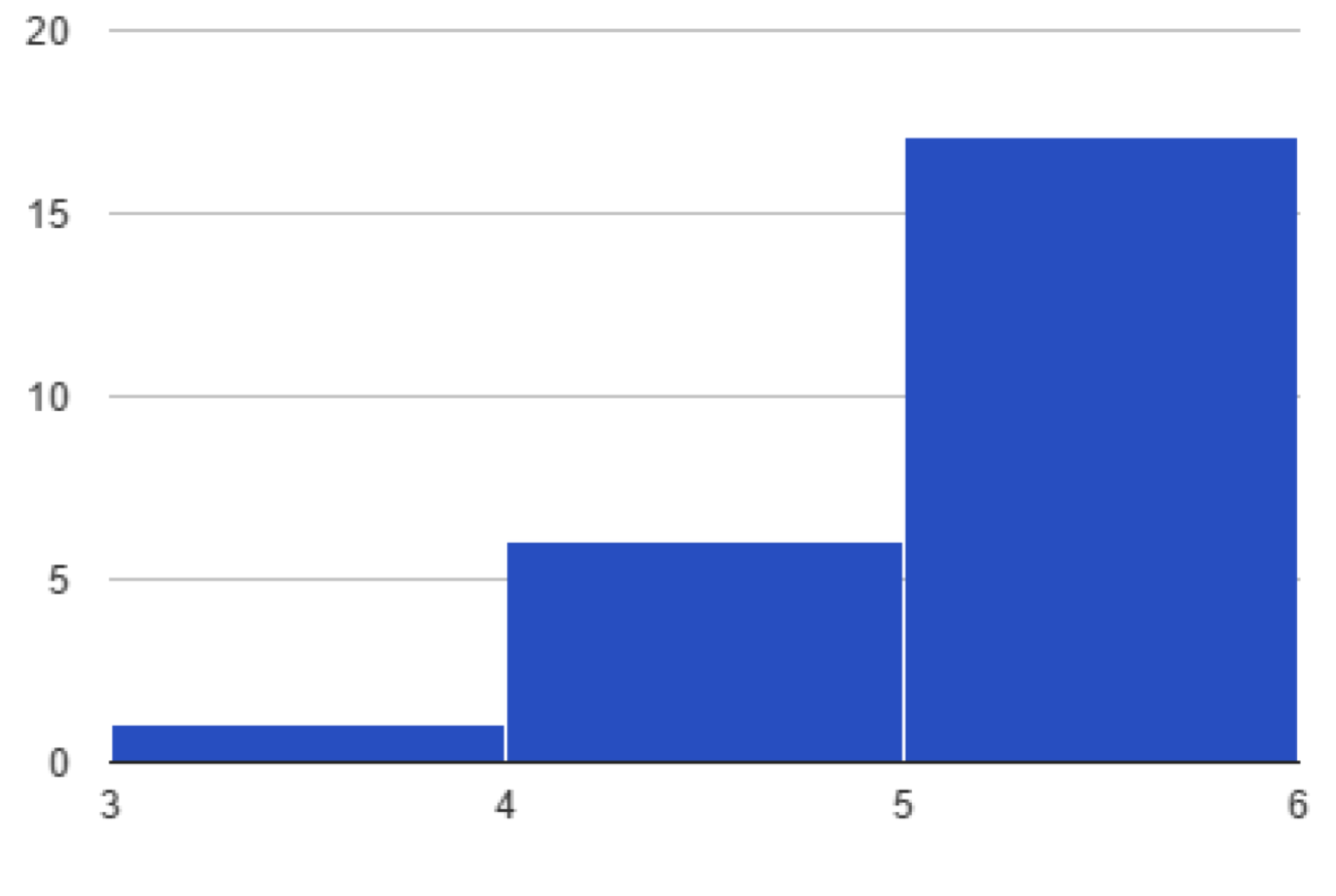
The responses also suggested that most students found the videos and interactive diagram valuable as well with the majority of responses being 3 or above. However, some students did not find the videos or the diagram valuable with several responses concerning each being below 3.
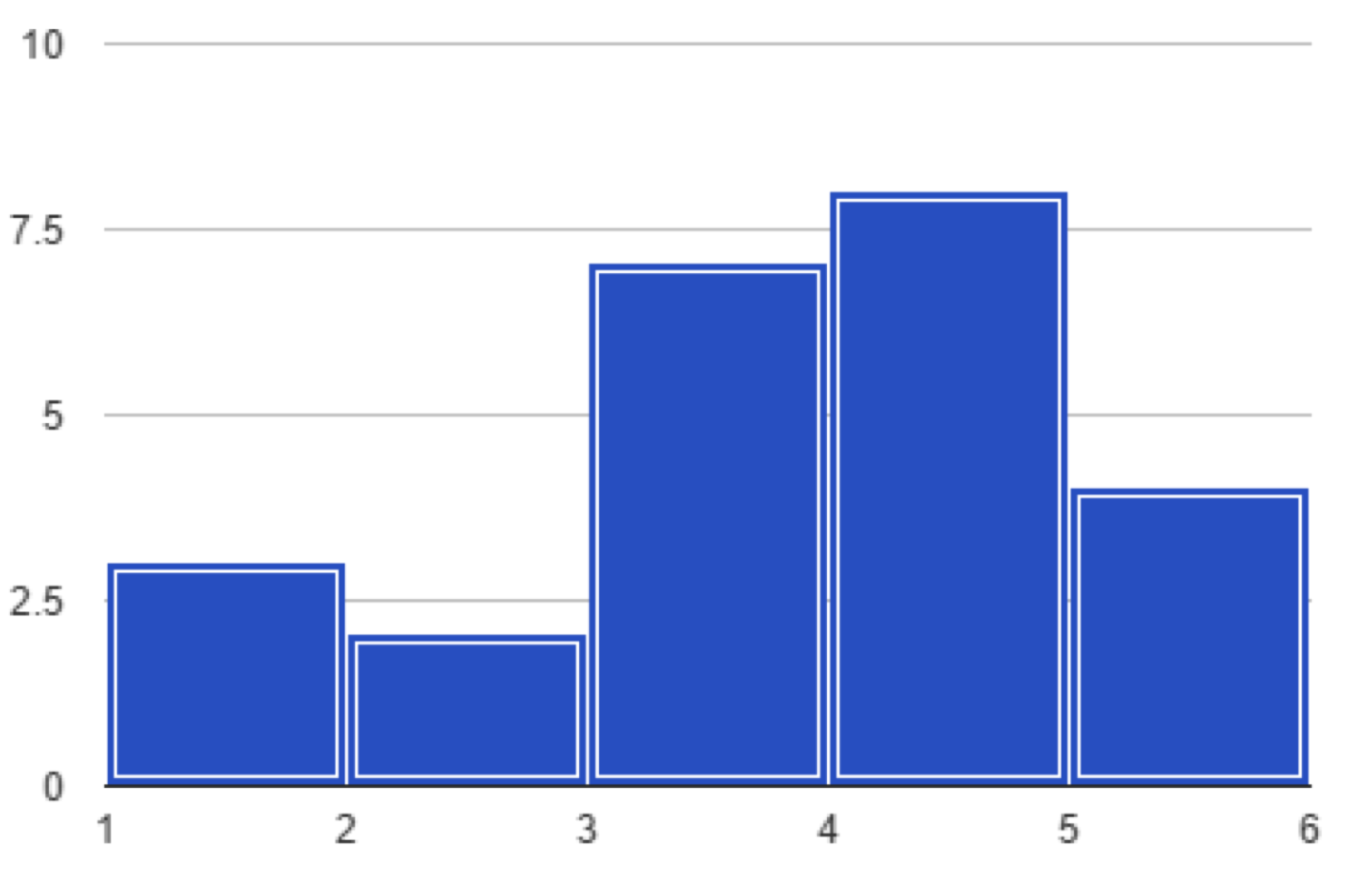

Taken together, these results suggest that our online module significantly increased student comprehension of the concept of time compensated sun compass navigation as well as their ability to use that knowledge to accurately predict butterfly mis-navigation events when the butterfly internal circadian time was offset from the external time.
Visit the Eastern North American Monarch Butterfly Migration and Navigation Website

